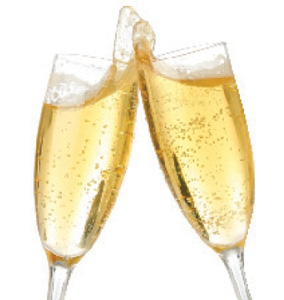A champagne toast - to the Island Sun

All of life’s milestones, birthdays and anniversaries should be celebrated with the tiny bubbles in champagne. Everything about champagne is celebratory. It starts with a pop. It leaps joyously from the bottle. In the glass it sparkles with fireworks and crystal lights. The bubbles slide giggling down your throat.
To say no to champagne is to say no to life.
So where do the bubbles come from?
Crudely put, wine is made when yeast drinks grape juice and urinates alcohol until it passes out in the alcohol. The yeast also passes gas - bubbles - in the process. Sounds like an Irish birthday party, but it is called fermentation.
The bubbles in champagne are the result of a second fermentation. The champagne maker makes wine and then adds a second dose of yeast and sugar - so the process starts again, but the bubbles are kept in the bottle.
The mythology of champagne has folk tale qualities.
Champagne’s creation is credited to a monk – a man of God. Dom Perignon was a cellar master in a monastery in Champagne, a province of France. He probably stumbled upon the art by putting wine in a container that had leftover sugar in it. After the good father mastered the basics of bubbles he tried to keep it a secret, but his little helper, Dom Ruinart, took off and carried the secret down the road to the next monastery. The bubbles were on the loose.
The champagne that the boys made was still a little crude. It had stuff floating around in it and looked more like beer than what we think of as crystal bright and sparkling champagne. It took a woman to make champagne beautiful. The widow Clicquot – in French the veuve Cliquot - radically improved the look of champagne by improving the processes of riddling and degorgement.
Riddling is the time consuming task of gradually moving particles that are in suspension in the champagne down the bottle to the neck. The bottles are tapped, turned, racked and increasingly inverted until the bottle is upside down and the junk is in the neck. Then the neck is frozen, the bottle is opened, the frozen deposits are removed - degorged - and the bottle is recorked and wired shut again.
The widow’s portrait is still on the famous orange label of Veuve Clicquot. She is kind of scary looking. She spent a lot of time in the basement lugging wine bottles.
Like too many other great things in life, champagne is expensive. Making champagne is a lot more work and requires more time and storage space. The best champagne has the tiniest bubbles - bubbles made smaller by compressing the gases for longer periods. The compression from those bubbles requires thicker, stronger and more expensive bottles. And then there is all that racking and riddling and disgorging.
There is a lot of labor and a lot of love in those bubbles. This week let’s raise a glass of love and bubbles to Mike and Maggie Field and the Island Sun staff, and toast them for making our Island a better place.

